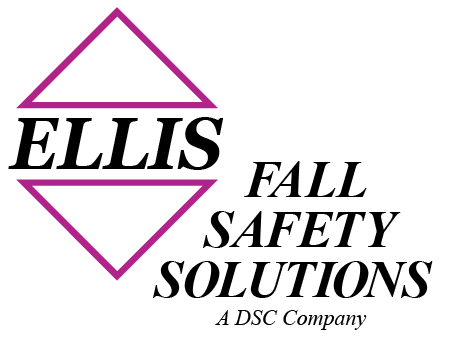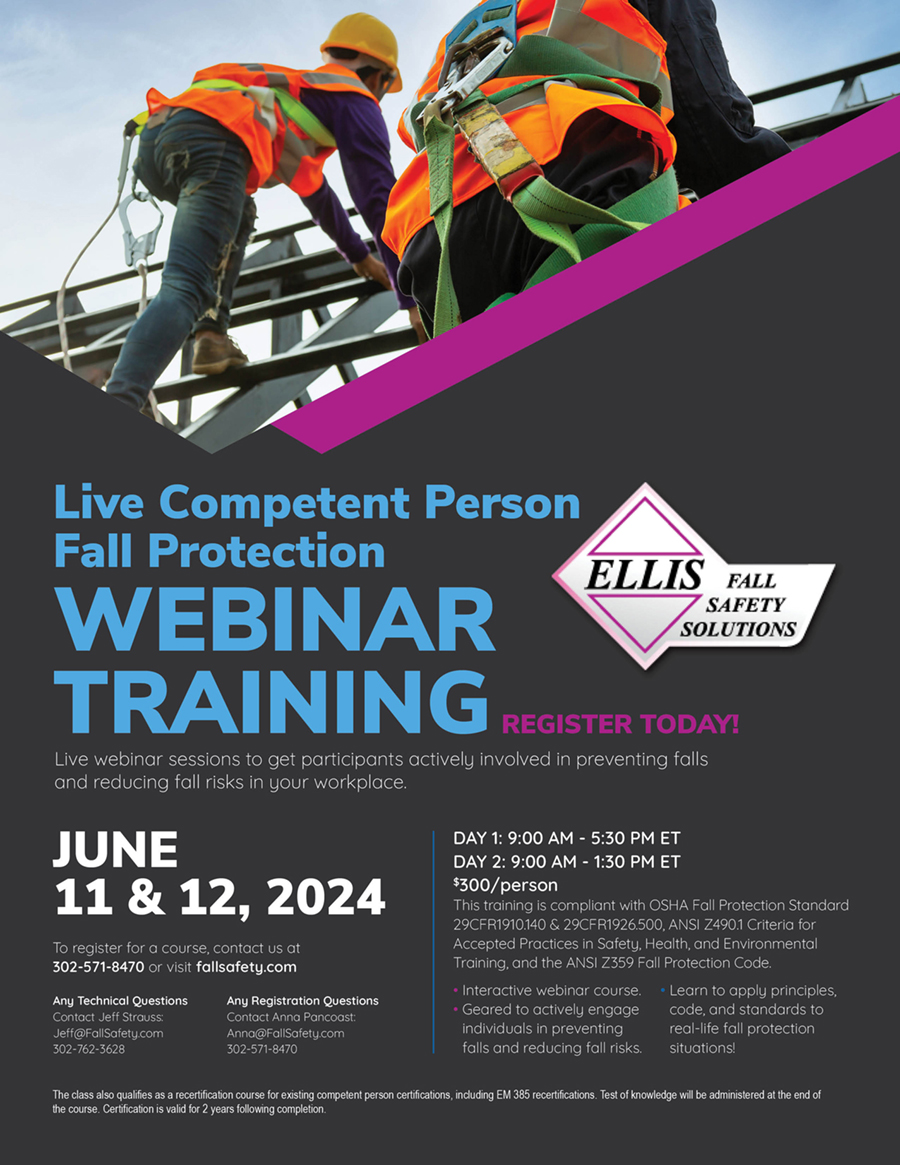Tip of the Week No. 184 – 11/05/07 Free Falls
Free fall and deceleration with fall equipment is also most easily measured from foot level before the falla to foot leve after the fall. A 6-foot lanyard, for instance, attached at foot level or below, could result in free falling 12 feet before the equipment is activated.
Since free falling is a transfer from potential energy to kinetic energy, the longer the free-fall distance, the higher the forces generated on impact.
See “Introduction to Fall Protection, 3rd Edition” page 133.
This book is an invaluable resource for every safety manager’s library. Click here to find out about ordering a copy. Order online now.
Tip of the Week No. 166 – 06/18/07 – Vertical Arrest Force
Most vertical arrest force problems can be minimized by the use of shock-absorbing mechanisms in the system and by using the manufacturer’s maximum arrest force specifications, while ensuring the capacity of the shock-absorbing lanyard is within limits (by properly limiting the length of the free fall).
See “Introduction to Fall Protection, 3rd Edition” page 222.
This book is an invaluable resource for every safety manager’s library. Click here to find out about ordering a copy. Order online now.
Tip of the Week No. 160 – 05/07/07 – Free Fall
Free fall and deceleration with fall equipment is also most easily measured from foot level before the fall to foot level after the fall.
A 6-foot lanyard, for instance, attached at foot level or below, could result in free falling 12 feet before the equipment is activated. Since free falling is a transfer from potentila energy to kinetic energy, the longer the free-fall distance, the higher the forces generated on impact.
See “Introduction to Fall Protection, 3rd Edition” page 133.
This book is an invaluable resource for every safety manager’s library. Click here to find out about ordering a copy. Order online now.
Tip of the Week No. 145 – 01/22/07 – Calculations for HLL for Multiple Workers
Engineered horizontal lifelines are capable of absorbing the force of several workers falling. The probability of more than one worker falling and dynamically impacting a horizontal cable in the same critical millisecond-range is remote.
Since typical lanyard arrest forces peak in the 5-millisecond duration range, the chances that multiple maximum arrest forces are going to be superimposed is extremely unlikely.
Factors leading to this conclusion are location on the line, weight, center of gravity and length of device or lanyard. Testing performed with two or three workers falling simultaneously indicates accumulation of forces by a factor of 20 percent each, beyond the first person.
See “Introduction to Fall Protection, 3rd Edition” page 229.
This book is an invaluable resource for every safety manager’s library. Click here to find out about ordering a copy. Order online now.
Tip of the Week No. 138 – 12/04/06 – Maximum Force during Fall Arrest
OSHA limits the threshold maximum force to which a worker may be subjected during a fall arrest event to 1,800 pounds (OSHA 1910.66, Appendix C).
The best method of assessing maximum arrest force is testing. An approximate numerical assessmentof this force presents a viable alternative when valid testing data is unavailable.
See “Introduction to Fall Protection, 3rd Edition” page 217.
This book is an invaluable resource for every safety manager’s library. Click here to find out about ordering a copy. Order online now.
Tip of the Week No. 137 – 11/27/06 – Free Fall Distance Calculations
Free-fall Distance:
The distance of the fall from the point of the attachment to the activation of the equipment. For instance, a 6-foot lanyard at waist level can result in a 6-foot fall.
See “Introduction to Fall Protection, 3rd Edition” page 135.
This book is an invaluable resource for every safety manager’s library. Click here to find out about ordering a copy. Order online now.
Tip of the Week No. 101 A – 01/30/06 – Max. Force Measurements
Fall arrest maximum force measurements can be established using test data supplied by the equipment manufacturer that has an instrumentation sensitivity range of 0.1-125 Hz, and that is free from interfering anchorage test-point resonance. (Refer to ANSI Z359.1-1992)
See “Introduction to Fall Protection, 3rd Edition” page 233.
This book is an invaluable resource for every safety manager’s library. Click here to find out about ordering a copy. Order online now.
Tip of the Week No. 108 A – 04/17/06 – Effect of Weight on Fall Loads
Since over 33 percent of American adults are obese or overweight, no belt should take a fall arrest load; a harness should be the medium in a fall arrest system that takes a load and more effectively distributes it around the body.
Same level and stairs falls are usually much more severe and diabling for heavier persons as well. Postfall suspension in belts, including harnesses with belts, is much more distressing for heavier persons.
See “Introduction to Fall Protection,3rd Edition” page 135.
This book is an invaluable resource for every safety manager’s library. Click here to find out about ordering a copy. Order online now.
Tip of the Week No. 16 A – 03/22/04 Acrometry
Establishing the topography of the workplace in order to plan fall protection security is essential. Known as acrometry, it is a new planning skill engineers must master.
See “Introduction to Fall Protection” page 61.
How about ordering a copy of for yourself? Order online now.
Tip of the Week No. 34 A – 07/26/04 Free Fall Calculations
Maximum Free-fall Distance:
No person should be able to free fall more than 6 feet at any time, from any position; this should be guaranteed by the method of hook-up to the fall protection system or by the lanyard length.
See “Introduction to Fall Protection, 3rd Edition” page 107.
How about ordering a copy for yourself? Order online now.
Tip of the Week No. 42 A – 10/04/04 – Engineered Protection
The engineers who prepare worksites for use of fall arrest equipment have a responsibility to review their designs and work methods with the responsible safety manager.
Approval for attachment to fall arrest equipment means much more than being able to sustain static leaning force of 200 pounds specified for perimeter protection.
It means the equipment must be capable of sustaining a free fall or MAF.
See “Introduction to Fall Protection, 3rd Edition” page 233.
Tip of the Week No. 5 A – 01/05/04 Free Fall Controls
Controlling a fall hazard begins by setting specific objectives defined by the elements of the hazard itself. For example, to control the energy generated through a fall, the free-fall distance should not exceed 2 feet. Additionally, reducing the total fall distance (free fall plus deceleration distance) can help decrease the possibility of striking an obstruction within the fall path.
See “Introduction to Fall Protection, 3rd Edition” page 135.
How about ordering a copy of for yourself? Order online now.
Tip of the Week No. 53 A – 01/03/05 – Clearance Calculations
Important: 15.5 ft. minimum clearance needed from grade level or any potential obstruction below the critical rope grab attachment point for additional slide after lock on.
Note: Fall arrester devices should be evaluated individually.
See “Introduction to Fall Protection, 3rd Edition” page 139.
How about ordering a copy for yourself? Order online now.
Tip of the Week No. 63 A – 03/21/05 – Anchorage Point Calculations
Minimum Anchorage-Point Height
(Self-Retracting Lanyard/Lifeline Device)
For Free Fall = 5’+L-H+A=A=2ft.
For Clearance = 5’+L-H+A+S [S=3.5’max. and A=2’max(OSHA)]=S+A=3.5’+2″=5.5ft.
A= activation distance
S= deceleration distance or elongation
H= 5’+L for harness users
L= total length of lifeline
See “Introduction to Fall Protection, 3rd Edition” page 137.
How about ordering a copy of for yourself? Order online now.
Tip of the Week No. 7 A – 01/19/04 Fall Arrest Measurements
Fall arrest maximum force measurements can be established using test data supplied by the equipment manufacturer that has an instrumentation sensitivity range of 0.1 – 125 Hz, and that is free from interfering anchorage testpoint resonance. (refer to ANSI Z359.1-1992)
See “Introduction to Fall Protection, 3rd Edition” page 233.
How about ordering a copy of for yourself? Order online now.
Tip of the Week No. 91 A – 11/14/05 – Free Fall Calculations
Free fall and deceleration with fall equipment is also most easily measured from foot level before the fall to foot level after the fall.
A 6-foot lanyard, for instance, attached at foot level or below, could result in free falling 12 feet before the equipment is activated.
Since free falling is a transfer from potential energy to kinetic energy, the longer the free-fall distance, the higher the forces generated on impact.
See “Introduction to Fall Protection, 3rd Edition” page 133.
How about ordering a copy for yourself? Order online now.
Introduction to Fall Protection, 4th Edition #4
Tip of the Week No. 322:
Just as establishing critical path planning of the work is essential in planning for fall safety, establishing the topography of the workplace in order to plan fall protection security is essential.
Known as acrometry, it is a new planning skill engineers must master.
Excerpt from Chapter 3 – Who Needs Fall Protection? Introduction to Fall Protection, 4th Edition. Watch this website for more information about the publication date and how you can order your copy.
Tip of the Week No. 275 – 03/08/10 – Free Fall Calculations
Free-fall Distance:
The distance of the fall from the point of the attachment to the activation of the equipment. For instance, a 6-foot lanyard at waist level can result in a 6-foot fall.
See “Introduction to Fall Protection, 3rd Edition” page 135.
This book is an invaluable resource for every safety manager’s library. Click here to find out about ordering a copy. Order online now.
Tip of the Week No. 324 – 07/30/2012 – Bending Stress
Whenever horizontal scaffold component member is subjected to a vertical load, the horizontal member acts as a beam, and is subjected to several stresses including bending, shear, and others. These stresses can be calculated using standard engineering formulas. Bending stress is maximized at the midspan of the horizontal component and when the laod is imposed at te center. Bending is almost always the governing stres when scaffold tubes are used as a beam.
See Introduction to Fall Protection, 4th Edition page 145.
Introduction to Fall Protection, 4th Edition now available for purchase. To order your copy call 1-800-372-7775 or order online at Introduction to Fall Protection, 4th Edition Orders.
Tip of the Week No. 329 – 09/10/2012 – Clearance Distance
The overall clearance required (defined as A) is the distance between the cable anchorages and the top of the highest obstruction.
To determine the required clearance from the highest obstruction to the working surface, subtract the distance from the working surface to the cable termination anchorages from the previously mentioned total clearance required. Again, the Qualified Person (engineer) must ensure that free-fall distances are below the maximum as dictated by OSHA and/or the equipment being utilized.
See “Introduction to Fall Protection, 4th Edition” page 302.
Introduction to Fall Protection, 4th Edition now available for purchase. To order your copy call 1-800-372-7775 or order online at Introductionto Fall Protection, 4th Edition Orders.
Please select a category from the list below
- Aerial Lifts/Platforms
- Anchorage Points
- Calculations
- Construction Contracts
- Consulting
- Cranes
- Descent Devices
- Ellis Articles
- Ellis Presentations
- Equipment Maintenance
- Ergonomics/Human Factors
- Fall/Safety Statistics
- FP systems, programs
- Guardrails
- Harnesses, FP Equipment, HLL, SRL
- Hazards
- Holes/Pits
- Ladders
- Lanyards/Twin Tail Lanyards
- Misc.
- Nets
- New
- NIOSH
- OSHA News/Citations
- PFAS
- Rescue
- Roofs
- Ropes
- Safety Cases
- Safety Organizations
- Scaffolds
- Skylights
- Stairs
- Standard/Regulations
- Steel Erection
- Tanks
- Towers
- Training
- Tree Stands
- Trucks
- Tying Off
- Veterans of Safety
- Window Cleaners
- Workers Comp

